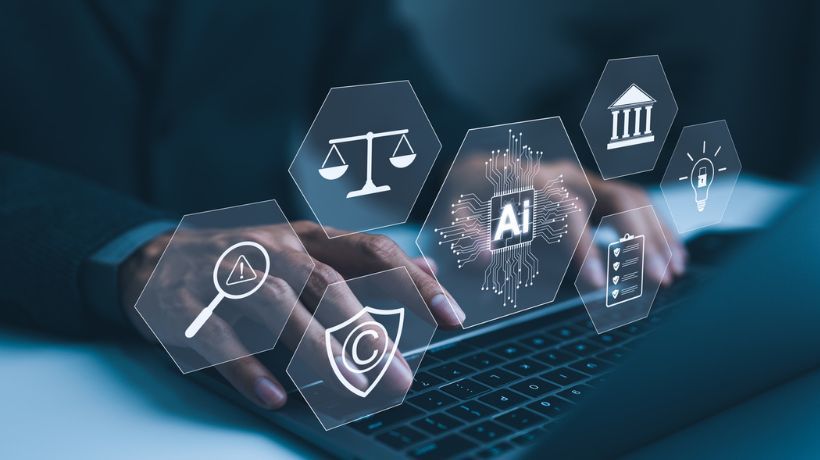[ad_1]
AI And Compliance: Balancing Innovation With Ethic
After a slow and uncertain start, the business case for AI is thriving. From operating models and workflows to decision making and product development, AI technology is improving workplaces.
It’s also forging a path to better organizational and societal outcomes. Such as better healthcare provision, greener and cheaper energy, and higher levels of public safety and security. The result? Across all industries, fear of the unknown has replaced excitement for the future.
But as the adoption of generative tech ramps up, concerns about AI are also building momentum.
How can organizations max out on automation and Machine Learning yet still uphold human values of ethics, equality, and trust?
With a potential storm brewing, AI compliance has blown in to disperse the clouds. A gentle breeze on the horizon for now, its force is steadily growing. And it’s issuing an urgent call to action for businesses.
So, how do AI and compliance work together? Let’s take a look.
What Is AI Compliance?
Regulatory compliance isn’t unique to AI. It’s a safeguarding mechanism that has multiple applications.
Generally speaking, it ensures businesses uphold standards, deliver transparency, and prevent misuse of power or position. Protecting customers and employees, it also protects organizations from potential legal and financial risks.
Cybersecurity and data protection are just two examples of regulatory mechanisms already in action. However, AI compliance is set to become the next big topic for organizations to address.
So, what is AI compliance? Applied to the emerging world of generative tech, AI compliance determines that AI-powered systems operate responsibly. By working together, AI and compliance aim to ensure that generative technology doesn’t:
- Break any laws or regulations
- Collect data illegally or unethically
- Discriminate against any groups or individuals
- Manipulate or deceive
- Invade someone’s privacy
- Cause harm to people or the environment
Why Is AI Compliance Important?
To a greater or lesser extent, AI automates and overrules human decision making. This hands-free approach threatens all of the use cases listed above, which is where regulatory change management and AI compliance come in.
AI regulatory compliance applies meaningful checks to stop AI-generated injustices and activities that threaten individuals or society.
It formalizes expectations, sets parameters, and provides a regulatory compliance framework for businesses to work to. Mitigating risk for organizations, it also sets and serves substantial punishments in the face of any regulations breached.
Global And Regional AI Compliance Regulations
Not all AI compliance regulations are made equal. And they’re certainly not in place everywhere—yet.
The level of formality and transparency linked to AI compliance varies from industry to industry, from one part of the globe to another, and even from state to state in America.
Let’s unpick the legislation landscape in the US and Europe. And look at how some of the most prominent users of the technology have set their own industry-specific AI compliance rules.
The EU AI Act
Approved by the European Commission in December 2023, the EU AI Act is leading the way for worldwide legislation of AI.
A comprehensive regulatory compliance framework, its reach is broad and global. It applies to all sectors and industries and any business worldwide developing or deploying an AI system within the EU.
The aim of the European Union’s act is to ensure that AI technologies don’t jeopardize fundamental human rights. What does this mean in practice? In essence, it means balancing AI-powered innovation with expected standards associated with safety, ethics, data quality, transparency, and accountability.
The EU AI Act’s AI compliance framework revolves around a multitiered, risk-based classification system. This ranges from high-risk AI systems to those posing “minimal risk.” The higher the level of risk, the stricter the standards. Examples of “high-risk” use cases include AI systems that impact health, safety, critical infrastructure, education, and employment.
State Regulations In The US
While the EU has centralized its AI compliance legislation, there is currently no single source of truth regulating AI in the US.
Yes, there are plans to introduce AI legislation and a federal regulation authority in the near future. But governance is generally inconsistent and varies from state to state. As it stands, just over a quarter of all US states have enacted AI-related legislation. [1]
That said, federal laws and guidelines exist that encourage the responsible development of AI technologies and safeguard against potential harm. These include:
- The White House Executive Order on AI, which promotes the “safe, secure, and trustworthy development and use of Artificial Intelligence.”
- The White House Blueprint for an AI Bill of Rights, which formalizes guidance around equitable access and use of AI systems.
Industry-Specific Regulations
As general legislation around AI compliance becomes more mainstream in the EU and beyond, certain sector-specific frameworks have also emerged.
The adoption of AI tools is growing at pace across financial institutions. Use cases range from algorithmic trading and risk modeling to surveillance programs and intelligent document processing.
Responding to this, the sector has started to set its own agenda. Designed to address bias and promote transparency, it’s introducing new regulatory compliance, risk, and legal policies and procedures surrounding AI. All of which are underpinned by the core compliance principles of training, testing, monitoring, and auditing.
The healthcare industry has also taken significant steps to address AI compliance. Working across key organizations, specific regulatory compliance standards now exist to underpin patient safety, data privacy, and ethics.
In the US, insurance, and employment sectors are just two examples of industries setting their own regulatory requirements.
A bulletin issued by the National Association of Insurance Commissioners now outlines governance frameworks, risk management protocols, and testing methodologies for the use of AI systems.
The use of AI during the hiring process is a hot topic in New York and Illinois.
In Illinois, the AI Video Interview Act ensures that employers seek consent from candidates before using AI to analyze video interviews. While in New York, a local regulatory compliance law now “prohibits employers and employment agencies [in the city] from using an automated employment decision tool” unless it complies with certain requirements. [2]
10 Strategies To Ensure AI Compliance
We’ve seen how some industries are taking matters into their own hands to provide a regulatory framework for the way they use AI. But what general guidance should organizations follow? What compliance tasks should be included in every organization’s compliance program? From risk management to training, here are 10 strategies to help support a successful approach.
1. Create A Governance Framework
- Define specific roles and responsibilities for monitoring AI compliance. Assign these to relevant individuals within your organization.
- Establish clear policies and procedures for AI use.
2. Promote Transparency
- Provide a rationale for AI models. Establish the purpose of each application of Artificial Intelligence and formulate a clear explanation of what it’s there for and why.
- Keep a centralized record of all AI systems, including data sources, algorithms, and decision-making processes. Ensure there’s comprehensive documentation in place to support this.
- Develop a process for reporting and responding to Artificial Intelligence compliance issues.
3. Level Up Data Protection
- Check that policies safeguarding personal data are thorough and comply with the latest regulations.
- Safeguard data. Use encryption and access controls to regulate access to sensitive information.
4. Carry Out Spot Checks
- Conduct “fairness” audits. Regularly inspect, evaluate, and modify AI systems for potential biases.
- Assess AI systems’ day-to-day performance. Cross-check AI models against key markers such as accuracy, reliability, and compliance with standards.
Stella Lee, AI strategist, discusses on Generative AI in L&D and the evolution of eLearning from TalentLMS’s podcast series, Keep It Simple, that it’s essential to engage our critical thinking skills to identify potential issues, understand limitations, fact-check information, and verify sources when using AI tools.
We need to put on our critical thinking hats and know where things might go wrong to know if there are limitations, how we fact-check, and how we verify sources.
– Stella Lee, AI Strategist
5. Manage Risk
- Compliance and risk management go hand in hand. Design risk management assessments and use these to pinpoint and prevent potential compliance risks associated with AI systems.
- Build mitigation strategies around identified regulatory compliance risks. Develop and implement incident response plans to address and resolve any compliance breaches or ethical issues.
6. Uphold Fairness And Equality
- Establish and enforce ethical guidelines. Use these to ground and guide the development and deployment of AI technologies.
- Form an ethics committee to evaluate and approve (or reject) AI projects. Use a predefined list of standards and compliance requirements to guide this process.
7. Consider The Bigger Picture
- Look beyond general AI compliance. Keep industry-specific regulations and interoperability frameworks front of mind too.
- Create a unified operating model. Integrate AI tools with existing systems to promote continuity, and to support the seamless and comprehensive exchange of data.
8. Raise Awareness And Engagement
- Bring stakeholders on board. Promote the purpose and power of AI compliance across all interested parties.
- Explain the fallout. Make it clear what will happen if AI compliance fails.
9. Keep A Close Eye
- Monitor evolving AI regulations and industry standards. By staying informed of regulatory changes, you can address any potential legal and regulatory issues before they hit.
- Foster a culture of continuous improvement. Update Artificial Intelligence systems and compliance practices accordingly when required.
10. Provide Ongoing Training
- Offer AI compliance training at the point of need using compliance training software. Cover topics such as the ethical use of AI, general strategies for success, industry-specific requirements, cybersecurity training, and best practices.
Pro tip: Craft compelling compliance training announcement emails to engage employees in what can be considered a dull and dry subject. - Customize learning programs using employee training software. Tailor AI regulatory compliance training to sync with your organization’s different roles, departments, and teams. For example, developers, data scientists, legal teams, compliance professionals, and executives will need different focuses and depths of information.
The Future Of AI Compliance: A Responsible And Reactive Strategy For Success
With AI technology comes responsibility.
AI compliance frameworks are the first important step toward regularizing that responsibility. But what works now won’t necessarily work tomorrow.
AI compliance management is still in its infancy. But it’s growing at pace. Every day, generative technology is becoming more intelligent and ubiquitous. Which means? The future of AI compliance will be defined by how organizations respond to ongoing changes in technology.
As the landscape shifts, organizations will need to be alert and responsive. Continuous oversight, adaptive strategies, a culture of ethical use, and ongoing education will all play a part in the long-term success of AI compliance. With these in place, gatekeepers will be able to navigate the complexities of compliance. And by doing so, uphold the key principles of fairness, trust, privacy, transparency, and accountability. All of which are vital to ensure that AI is a force for good for all.
References:
[1] United States approach to Artificial Intelligence
[2] AI Watch: Global regulatory tracker – United States

TalentLMS
TalentLMS is an LMS designed to simplify creating, deploying, and tracking eLearning. With TalentCraft as its AI-powered content creator, it offers an intuitive interface, diverse content types, and ready-made templates for immediate training.
[ad_2]
Source link

